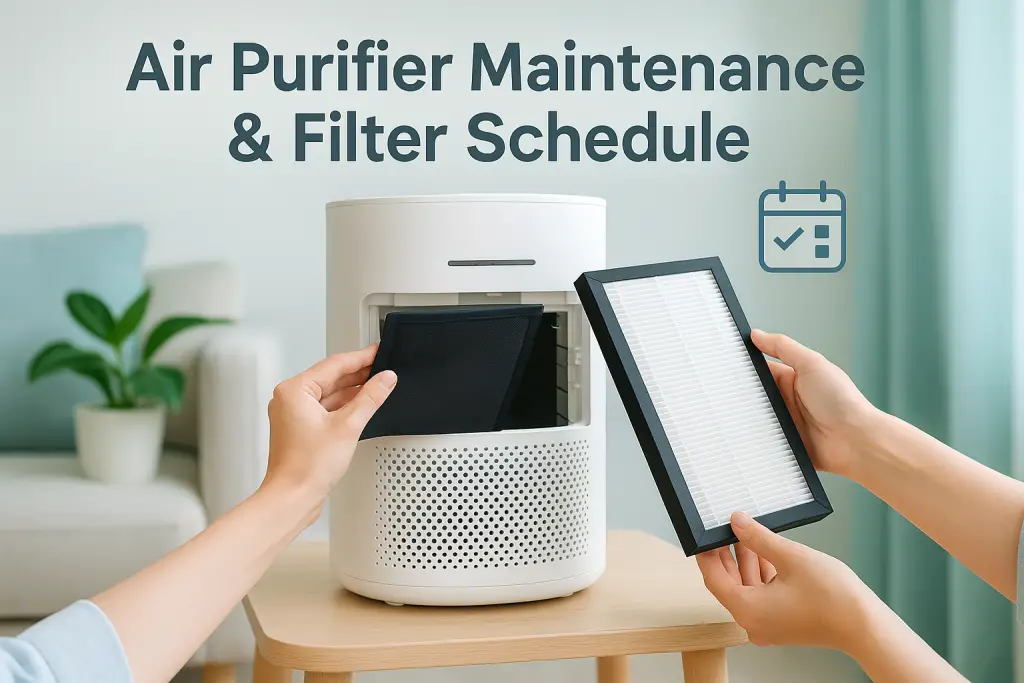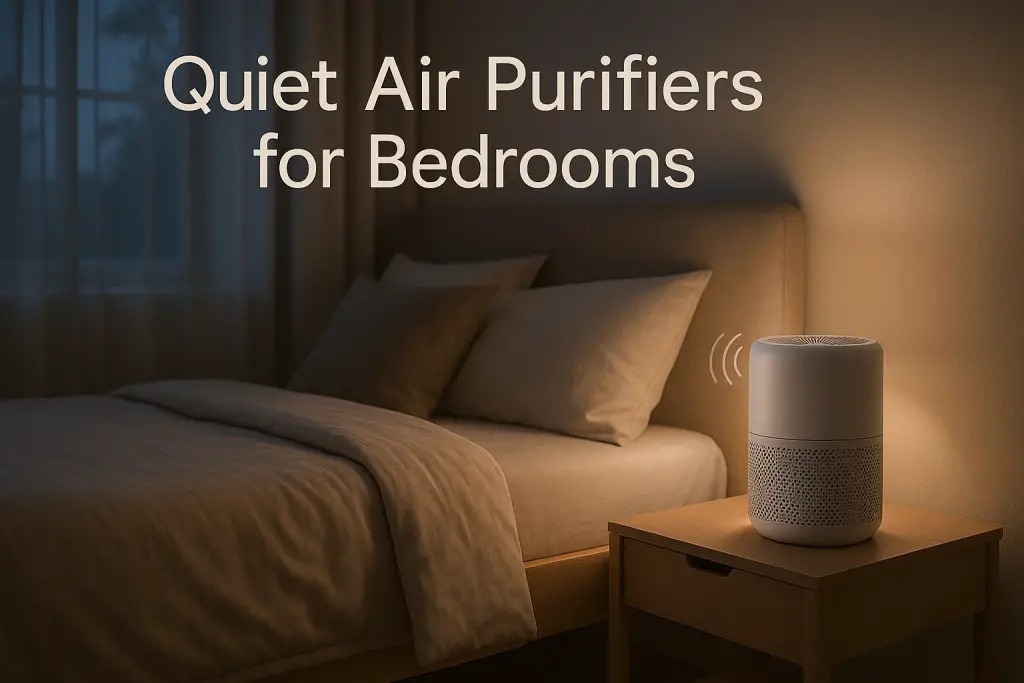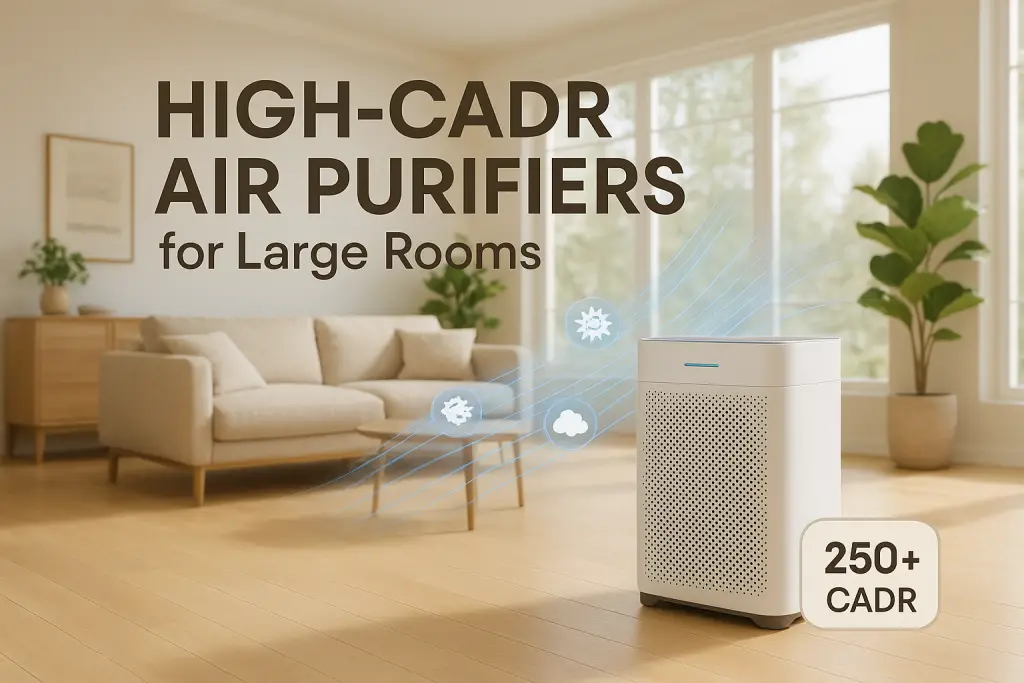Choosing between two air purifiers with similar CADR ratings can be challenging for many shoppers. Clean Air Delivery Rate (CADR) is an important metric, but it’s just one piece of the puzzle. When two models have comparable CADR numbers, you’ll need to evaluate several other factors to make the best decision for your specific needs and situation.
Understanding CADR Ratings and Their Limitations
Clean Air Delivery Rate (CADR) measures how quickly an air purifier filters specific pollutants from the air. CADR ratings typically cover three pollutant categories: tobacco smoke (smallest particles), dust (medium particles), and pollen (largest particles). While these numbers provide valuable baseline performance data, they don’t tell the complete story about an air purifier’s effectiveness.
CADR testing has several limitations:
- Tests run for only 20 minutes in a controlled chamber
- Doesn’t measure filtration of VOCs, odors, or gases
- Doesn’t account for real-world factors like furniture placement
- Doesn’t evaluate long-term performance as filters age
- Doesn’t measure noise levels or energy consumption
When is a CADR Difference Significant?
Before exploring other factors, determine whether the CADR difference between models is meaningful for your needs. Generally, differences under 20 points (within each pollutant category) are minimal. For example, an air purifier with a dust CADR of 220 versus one with 235 will have virtually identical performance in real-world use.
For small rooms (under 200 square feet), even a 30-40 point CADR difference may not significantly impact air quality. However, in larger spaces or for specific pollutant concerns, these differences become more relevant.
How to Choose Between Two Models with Similar CADR?
When CADR ratings are similar, you need a systematic approach to evaluate which air purifier offers better performance and value. Here’s a comprehensive framework of nine factors to consider:
Factor 1: Filtration Technology Beyond CADR
Two air purifiers with identical CADR ratings may use entirely different filtration methods with varying effectiveness against specific pollutants.
- HEPA Filtration: Look for true HEPA filters (H13 or better) rather than “HEPA-type” filters. HEPA filters trap particles physically, while ionizers charge particles to make them stick to surfaces—two very different approaches with the same CADR.
- Carbon Filtration: Check the amount and type of activated carbon. More carbon (measured in grams or pounds) typically means better odor and gas filtration.
- Pre-filter Quality: Washable pre-filters can save money and extend the life of main filters.
- Additional Technologies: Some purifiers include UV light, photocatalytic oxidation, or plasma technology for additional purification.
Factor 2: Noise Levels at Different Fan Speeds
Noise level is one of the most noticeable differences between air purifiers with similar CADR ratings, especially for bedroom use.
Check decibel (dB) ratings at different speeds:
- Below 30 dB: Whisper-quiet, suitable for bedrooms
- 30-40 dB: Quiet background noise, acceptable for living areas
- 40-50 dB: Noticeable but not distracting for daytime use
- Above 50 dB: Potentially distracting, similar to a refrigerator hum
Some manufacturers inflate CADR ratings by testing at maximum speed, which may be too loud for practical use. An air purifier that maintains good performance at lower, quieter speeds may be more valuable than one with slightly higher CADR but excessive noise.
Factor 3: Energy Efficiency and Operating Costs
Air purifiers with similar CADR ratings can have dramatically different energy consumption, affecting both your electric bill and environmental impact.
Energy Star certified models offer better efficiency while maintaining performance. To compare operating costs:
- Find the wattage for each model at typical settings (not just maximum)
- Multiply by hours used daily (usually 24 for continuous operation)
- Multiply by electricity cost per kWh in your area
- Compare annual costs between models
Example calculation: A 50W air purifier running 24/7 at $0.15/kWh costs about $65 annually to operate, while an 80W model costs around $105 per year—a $40 annual difference despite similar CADR.
Factor 4: Filter Replacement Costs and Schedule
Filter replacement costs can easily exceed the purchase price of an air purifier over its lifetime, making this factor critical when comparing similar models.
Compare these factors:
- Filter lifespan (6 months vs. 12 months makes a big difference)
- Replacement filter cost (can range from $20 to $200+)
- Filter indicator technology (timer-based vs. actual sensor-based)
- Availability of third-party compatible filters
- Filter subscription programs or multi-packs for savings
Annual filter cost calculation: (Filter price ÷ Filter lifespan in months) × 12
Factor 5: Room Coverage and Air Changes Per Hour
Similar CADR ratings don’t always translate to identical room coverage, making it essential to understand the Air Changes Per Hour (ACH) metric.
The ACH indicates how many times the air purifier can filter the entire room’s air volume each hour. For allergies and asthma, an ACH of at least 4-5 is recommended.
Manufacturers often cite room size based on 2 ACH, which is inadequate for allergy sufferers. To calculate effective room coverage for your needs:
- For 4 ACH: Take the manufacturer’s recommended room size and divide by 2
- For 5 ACH: Divide the recommended room size by 2.5
This calculation might reveal that two air purifiers with similar CADR actually have different effective room coverage for your specific needs.
Factor 6: Smart Features and User Experience
Modern air purifiers offer varying levels of smart functionality that can significantly impact user experience and effective air cleaning.
Compare these features:
- Air quality sensors: Some detect only particles while others also detect gases/VOCs
- Auto mode effectiveness: How quickly and accurately the unit responds to air quality changes
- App functionality: Remote control, scheduling, historical air quality data
- Smart home integration: Compatibility with Alexa, Google Home, Apple HomeKit, etc.
- Display options: Air quality indicators, filter life remaining, current settings
- Child lock features: Important for households with young children
- Sleep mode: Does it dim lights and reduce noise automatically?
Factor 7: Build Quality and Warranty
The durability and manufacturer confidence in an air purifier can be assessed through build quality indicators and warranty terms.
Evaluate:
- Warranty length: Longer warranties often indicate manufacturer confidence
- Motor quality: Brushless DC motors typically last longer than conventional motors
- Materials: Sturdy plastics versus cheap, flimsy construction
- Button/control quality: Solid feel versus loose or sticky controls
- Customer support reputation: Check reviews for warranty claim experiences
- Availability of parts and service after warranty period
Factor 8: Size, Design, and Placement Flexibility
Physical dimensions and design affect both aesthetics and the practical placement options for your air purifier.
Consider:
- Footprint dimensions: Will it fit in your intended space?
- Height: Taller units may be less stable or more obtrusive
- Air intake and output locations: Some require more clearance around the unit
- Cord length and placement: Is the power cord long enough for your needs?
- Portability: Handles, weight, and wheels for moving between rooms
- Visual design: Will it blend with your home decor or stand out?
Factor 9: Special Features for Specific Needs
Depending on your specific health concerns or environment, certain specialized features may outweigh small CADR differences.
For allergy and asthma sufferers, look for certified asthma & allergy friendly models with specialized features that address your specific triggers.
Other specialized features to consider:
- Pet-specific features: Enhanced odor control, pet hair pre-filters
- VOC and chemical sensitivity features: Enhanced carbon or molecular filtration
- Ozone-free certification (especially important for those with respiratory conditions)
- Smoke removal capabilities: Important for wildfire-prone areas
- Specialized modes: Night mode, allergen season mode, cooking mode
For those experiencing headaches and fatigue possibly linked to indoor air quality, look for models with advanced VOC filtration and real-time air quality monitoring.
Practical Comparison Example Using Our Framework
Let’s apply our 9-factor framework to compare two popular air purifiers with similar CADR ratings: the Coway AP-1512HH and the Winix 5500-2.
- CADR Ratings: Both have similar CADR ratings (Coway: 240/246/233, Winix: 243/246/232 for dust/pollen/smoke)
- Filtration: Both use True HEPA, but Winix has a slightly larger carbon filter
- Noise: Coway is quieter at lowest setting (24.4 dB vs 28 dB)
- Energy: Coway uses 77W max vs Winix’s 70W max
- Filter Costs: Coway replacement filters cost around $50 annually, Winix around $60
- Coverage: Both rated for ~360 sq ft, meaning about 180 sq ft at 4 ACH
- Smart Features: Winix has more advanced air quality display
- Warranty: Coway offers 3 years vs Winix’s 2-year warranty
- Size/Design: Coway has smaller footprint, Winix is slightly taller
Decision: For a bedroom, the Coway might be preferable due to lower noise levels and longer warranty. For a living room, the Winix might be better with its enhanced air quality display and slightly better odor control.
Decision-Making Worksheet for Air Purifier Comparison
Use this structured approach to compare any two air purifiers with similar CADR ratings:
- List both models’ CADR ratings for all three pollutants
- Score each model on all nine factors (1-5 scale)
- Weight each factor based on your personal priorities (1-3 scale)
- Multiply scores by weights
- Add up weighted scores to determine overall winner
Remember that your personal priorities should drive this process. Someone with severe allergies might heavily weight filtration technology and ACH, while someone for a bedroom might prioritize noise levels and sleep mode features.
Final Recommendations: When to Prioritize Each Factor
Your specific situation should determine which comparison factors to prioritize:
- For Allergy/Asthma Sufferers: Prioritize filtration technology, ACH rate, and specialized certifications
- For Bedroom Use: Prioritize noise levels, sleep mode, and display dimming
- For Large Open Spaces: Prioritize effective room coverage and fan strength
- For Budget-Conscious Buyers: Focus on total cost of ownership (purchase price + energy costs + filter costs)
- For Tech Enthusiasts: Prioritize smart features, app control, and integration
- For Pet Owners: Focus on odor control capabilities and pre-filter effectiveness
- For Chemical Sensitivity: Prioritize VOC/gas filtration and certifications
Frequently Asked Questions About Air Purifier Comparison
Is a higher CADR always better?
Not necessarily. A slightly higher CADR might come with tradeoffs like increased noise, higher energy consumption, or shorter filter life. The difference may be insignificant in real-world use.
How significant is a 20-point CADR difference?
For most home users, a 20-point difference (e.g., 200 vs. 220) is barely noticeable in actual performance, especially in smaller rooms.
Should I trust manufacturer CADR claims?
Look for AHAM-verified CADR ratings, which have been independently tested using standardized methods. Unverified claims may be less reliable.
Do CADR ratings change as filters age?
Yes. CADR testing uses new filters, but performance typically decreases as filters become loaded with pollutants. Some higher-quality models maintain performance better than others.
How does room layout affect CADR effectiveness?
Room divisions, furniture placement, and air circulation patterns can all affect real-world performance. A slightly lower CADR unit placed optimally may outperform a higher CADR unit in a poor location.
Conclusion: Making Your Final Decision
When choosing between air purifiers with similar CADR ratings, remember that CADR is just one measure of performance. By evaluating all nine factors in our framework and weighing them according to your specific needs, you can make a more informed decision that goes beyond simple numbers.
Focus on the total ownership experience: initial cost, ongoing expenses, practical usability in your space, and specific features that address your air quality concerns. The “best” air purifier isn’t necessarily the one with the highest CADR, but the one that best meets your unique requirements while providing reliable performance over time.
Take time to research each model thoroughly using this framework, and you’ll end up with an air purifier that truly meets your needs rather than just winning a numbers game.
| Photo | Air Purifier Model | Best for | Price |
|---|---|---|---|

|
WINIX A231 Air Purifier | Asthma & Indoor Pollution | Check Price On Amazon |

|
Rabbit Air, A3 SPA-1000N Air Purifier | Pet Dander & Odors | Check Price On Amazon |

|
LEVOIT Air Purifier | Best Overall | Check Price On Amazon |

|
GermGuardian Air Purifier | Cigarette & Cooking Smoke | Check Price On Amazon |

|
Coway Airmega Air Purifier | New-borns | Check Price On Amazon |

|
BLUEAIR Air Purifier | Germ & Virus Control | Check Price On Amazon |






